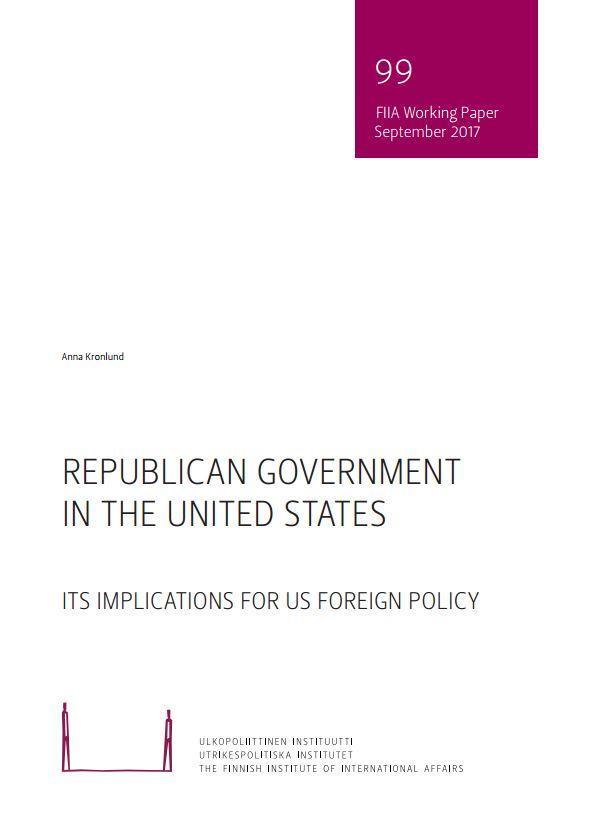
Donald Trump’s first year in office is approaching its end. While the most feared scenarios in the area of US trade policy have not materialized, some ongoing developments are a serious cause for concern. This is especially the case with regard to US scepticism towards the WTO. Trump is continuing his tactic of dismissing the bigger picture about the overall benefits of trade, and is focusing on the negative side effects of globalization. However, instead of addressing these side effects with appropriate regulatory responses, he is trying to please his electorate by blaming unfair trade agreements and immigration.
The Trans-Pacific Partnership (TPP) remains the only trade agreement that Trump has abandoned so far. The North American Free Trade Agreement (NAFTA) is currently being renegotiated. The antiquated agreement would benefit from updated disciplines, but Canada and Mexico are not likely to agree to Trump’s excessive and partly irrational demands. In the meantime, the TPP seems to be going ahead without the US. Regarding China, Trump has softened his stance. The two countries recently engaged in lucrative business agreements worth 250 billion dollars. However, the agreements do not address the structural market issues that American businesses have been most concerned about and seem aimed at disguising the lack of progress in real issues.
Introduction
When Donald Trump took office in January 2017, he formulated the new US trade policy in very simple terms: it meant putting America First. However, he struggled to explain what such a policy meant in reality – let alone how to reach it. Now that the end of Trump’s first year in office is approaching, a clear understanding of how to put America First is still lacking. However, the most feared scenarios regarding America’s shift to economic protectionism have thus far been avoided. The US President has not started any trade wars and the Trans-Pacific Partnership (TPP) remains the only trade agreement that he has abandoned to date.
Some of President Trump’s actions should, however, be a serious cause for concern. This is especially the case with the US attitude towards the World Trade Organization (WTO). The US expressed criticism towards the WTO’s dispute settlement even during the Obama administration, but the tone has become tougher of late. In addition, Trump’s obsession with bilateral trade agreements has meant the freezing of any new regional projects, which has far-reaching consequences globally. Moreover, by making constant threats in relation to raising tariffs and applying various other actions to protect American jobs and businesses, Trump is undermining the predictability that is essential for all economic operators, both foreign and domestic.
This Briefing Paper analyses President Trump’s major actions in the area of trade policy so far. It summarizes the first post-election developments, especially the US withdrawal from the TPP and the opening of re-negotiations for the North American Free Trade Agreement (NAFTA) with Canada and Mexico. The Trump administration’s early reactions towards China and the WTO are also covered.
It is argued that President Trump’s threats should not be afforded too much weight, but also prevented from growing. As a counterweight, the international community must be vocal in defending the existing frameworks of global economic governance. The US attitude towards the WTO’s well-functioning and highly regarded dispute settlement is considered particularly worrying and it is argued that the other WTO members, and especially the EU, must continue strongly supporting the organization as the cornerstone of the global trading system.
At the same time, the reality is that regionalism is being reinforced as practically all new trade agreements are concluded outside the WTO. While Trump is advocating bilateral agreements, the TPP (without the US) and the China-centred Regional Comprehensive Economic Partnership (RCEP) are moving forward. As a result, the US’s global influence is likely to decrease while China’s role will expand. However, Canada, Japan, and the EU are also strong players and may have the possibility to shape the global trading rules of the future. On the other hand, the Transatlantic Trade and Investment Partnership (TTIP), the bilateral trade project between the US and the EU, is currently on hold. However, Donald Trump is not the only reason why the TTIP has stalled. Taking it forward would require new approaches on both sides.
On the lookout for great deals
Trump’s key message so far has been that instead of signing large regional trade agreements (such as the TPP), the US should negotiate bilateral trade pacts. In the president’s words, they are better deals and will return jobs and industry to American shores. The issue is related to his obsession with trade deficits as he seems to believe that the US can better control trade flows through bilateral relations.
The move is perplexing considering that the reality of global production networks calls for the approximation of rules in larger regions rather than through bilateral agreements. However, the focus on bilateral trade deficits befits the Trumpian ideology, which dismisses the bigger picture about the overall benefits of trade and focuses instead on the negative side effects, such as job losses in certain sectors. The big picture, however, still shows that the US is benefiting from globalization and integrated markets, particularly with its neighbours through NAFTA.1 Import competition has naturally had significant effects on manufacturing jobs in the US, but the influence of automation and technology should not be underestimated either. Trade critics also tend to ignore the positive (lowering) effect that trade has on consumer prices, thereby contributing to the economic wellbeing of all Americans. Trump seems convinced that other countries are benefiting at America’s expense, but in reality bilateral trade deficits have very little to do with who is winning. Instead, they relate more to the US domestic economy.2
Trump has pledged to renegotiate all of the “bad deals” that the US has entered into. So far, he has made moves only on the TPP (withdrawal) and NAFTA (opening renegotiations). With regard to a recent free trade agreement between the US and South Korea (KORUS), the US has expressed its willingness to revise the agreement. It is unclear whether South Korea will agree to such a revision, especially considering that US accusations seem to be on very shaky ground.3
With NAFTA, the US has gone a step further. Canada and Mexico have agreed to renegotiations and the first round was held back in August. The situation is, however, crucially different compared to Korea. KORUS is a recent agreement and some of its commitments have not yet even entered into force. NAFTA, on the other hand, entered into force over 20 years ago and has become partly outdated. At the time of its conclusion, NAFTA was a modern and innovative trade agreement. For example, it was the first such agreement to include an extensive discipline on intellectual property rights as well as provisions on the environment and labour (albeit non-enforceable ones). Today, it has become antiquated, however, especially due to radically deeper integration in global and regional supply chains and the revolution in digital technologies. New disciplines are needed, especially in the areas of digital trade and services.4
Canada and Mexico are aware of this and hence agreeing to talks did not amount to a huge concession on their part. Their leaders must reckon that Trump would not terminate the agreement given that the US needs NAFTA as much as they do. However, Trump is playing hardball. He is showing his determination by making public threats and hinting at probably terminating the agreement in any case. Even if the threat is exaggerated, Canada and Mexico must demonstrate that they are serious about reviewing NAFTA.
For a protracted period of time, the US administration lacked a coherent vision on just what its exact goals for NAFTA would be. In light of the negotiation objectives released in July, we now have further clarity. The key objective of the US is, unsurprisingly, “a much better agreement that reduces the US trade deficit”. The US is basically looking for wider market access for its products, which is to be achieved by “seeking the highest standards covering the broadest possible range of goods and services”.5 Since most tariffs have already been eliminated between the three countries, this is to be accomplished by tackling technical barriers that make exports expensive, burdensome or even impossible in some cases.
Among several contentious negotiation areas, one that is especially fraught concerns the rules of origin. These are the complex rules that are applied to determine whether specific goods qualify as originating goods under the terms of NAFTA. The purpose is to ensure that NAFTA’s benefits are not extended to goods that are exported from non-NAFTA countries and which have undergone only minimal processing in North America. The US wants to update and strengthen these rules in order to ensure that the benefits of the agreement go to products genuinely made in North America. The rules of origin in NAFTA are outdated, but the danger in pushing for too much North American content lies in disrupting the value chains created thus far.
Considering the areas that have been identified to date by the US as being subject to negotiation, it is ironic that the TPP is thus far the only trade agreement from which Trump has pulled out completely. The TPP was negotiated as precisely the kind of modern trade agreement that would address some of the pressing issues that the US administration is now talking about, such as digital trade, free cross-border data flows and enforceable rules on labour rights. However, the TPP became a victim of extreme politicization during the election campaign, with Hillary Clinton turning against the pact in the end as well. Trump hardly had any other option than to exit. Now the US has the possibility to bring in some of the changes through NAFTA if Trump manages to control his most selfish instincts and reach a reasonable agreement for all three countries. At the moment, however, the deadline for negotiations has been postponed from the end of 2017 to the first quarter of 2018 with the Canadians and Mexicans accusing the US of a “winner-takes-all” mindset.
China – to blame or not to blame?
Getting tough on China was another of Donald Trump’s top campaign promises. The US is not the only state concerned about fair competition on the part of China. Many businesses in the EU have been similarly concerned about the unfair advantage that Chinese economic operators are gaining through state subsidies and the various forms of discrimination faced by foreign companies in China. One of the key issues in this regard is the battle over China’s status as a market economy in the WTO. However, President Trump has stood out among world leaders in his particularly tough stance on the country.
Trump has typically classified China alongside NAFTA as one of the biggest sources of misfortune for the American worker. He has constantly reiterated the idea that Beijing is using unfair trade practices to make US products uncompetitive on the world market. One of his main preoccupations was to label China a “currency manipulator”, claiming that the Chinese government was taking illegitimate steps to keep the yuan’s value artificially low. Although expert opinion no longer supported this, Trump refused to budge on this stance during the election campaign and said he would slap a 45 per cent retaliatory tariff on Chinese imports once in office.
After taking office, Trump became more muted on the subject of currency manipulation but initiated two separate procedures that have potentially negative consequences for the Chinese economy. The first is a national security review of Chinese steel. Europeans have also been concerned about the over-supply of Chinese steel in the international markets but the American approach seems openly protectionist as to its choice of method. Moreover, if subjected to WTO litigation, the US has threatened to invoke the national security option, which is regarded as the nuclear option in WTO law. The WTO’s legal system affords leverage to countries choosing to use this option, but its limits are unclear due to practically non-existent case law. The risk is that were the WTO to find in favour of the US in a dispute settlement, this could amount to carte blanche when it comes to invoking the provision and thus lead to a new protectionist instrument for all WTO members. On the other hand, were the WTO to rule against the US, Trump might choose to ignore the ruling and seriously undermine the credibility of the organization.
Nonetheless, the situation seems to have been resolved for the time being. China backed down and one week after the July G20 summit in Hamburg it proposed cutting steel overcapacity by 150m tons by 2022. Trump reportedly walked away from the offer and stuck to his demand for increased tariffs. He has not taken any action in this regard but since then China has cut back on its steel production and global steel prices have recovered. Hence, Trump’s tactic may have paid off on this occasion.
The second concrete action taken by Trump towards China is the launch of a review into compulsory technology transfers and the theft of American intellectual property by Chinese companies. Considering the threats against China voiced on the campaign trail, the approach appears quite mild. It consists of launching a process that could continue with a formal investigation. The investigation would likely take up to a year and would include negotiations with Beijing and wider consultations with business.6 What is worrisome is that the US is considering launching a domestic investigation instead of taking the issue to the WTO. Trump’s strategy may, however, be to incentivize the Chinese to agree to buy further American products to avoid a trade war, thereby allowing him to save face to a certain extent at least.
This strategy played out during Trump’s recent visit to China on his big East Asia tour at the beginning of November. Amid Trump’s obvious admiration for President Xi Jinping, China and the US concluded several significant agreements in which China engaged in purchases worth 250 billion dollars. No matter how lucrative for the US, the individual purchases and investment agreements do not address the structural issues in the two countries’ trade relations. Moreover, the overall sum is less than the trade deficit that the US has recently been accumulating with China over a one-year period.7 US businesses still have many long-standing concerns to complain about, including unfettered access to the Chinese market, big subsidies to domestic companies, the theft of intellectual property and cybersecurity. However, the agreements allowed Trump to portray himself as a master dealmaker, while drawing attention away from a lack of progress on addressing the real concerns.
Sabotaging the WTO
Negotiations at the WTO were moribund even before Donald Trump took up his current position. However, a worrying development is taking place regarding the WTO’s dispute settlement, which is the most efficient and functioning part of the organization. The US has been critical of the WTO’s dispute settlement body’s highest organ, the Appellate Body, for some time now.
The WTO Appellate Body is a seven-member independent court that takes the final decision on the meaning of WTO law and its application to WTO members. AB members are nominated and appointed by member-state governments and serve a maximum of two four-year terms. In the first half of 2016, during the Obama administration, the US blocked the re-appointment of a South Korean judge by citing his role in a series of decisions with which the US disagreed. This was heavily criticized by other WTO members as being tantamount to meddling with the independent judiciary.
In the end, another Korean national was appointed but in August he unexpectedly resigned, taking up a position as trade minister in the Korean government. The US has since been blocking the recruitment of new judges, exacerbating the risk that the WTO could effectively run out of judges. In a statement in August, the US said it would not move forward with the appointment procedures before its systematic concerns regarding the dispute settlement had been addressed. The goal thus seems to be to pile pressure on other WTO members to accept US plans for reform, which appear to be going potentially as far as to open the door for individual WTO member states to block appeal rulings in certain cases.
The US attitude has raised fears about Trump’s reaction to any major negative WTO ruling being issued against the US during his term. Moreover, it paints a worrying picture of the US administration’s shift in thinking towards the principal governing structures of world trade. During a rare public appearance in Washington in September, Robert Lighthizer, the US Trade Representative, sent mixed signals on whether the administration would be willing to take its trade disputes to the WTO. He also contrasted the ways in which Europeans and Americans see trade agreements. According to Lighthizer, Americans tend to see them as contracts, enforcing a clearly defined set of rights and obligations, whereas Europeans and certain others see them as an evolving form of governance. The comment highlights the general suspicion and criticism that the current US administration is projecting towards the WTO and global governance at large. On the same occasion, he argued that the WTO was not equipped to deal with China and underlined that the US must find other ways to defend its companies, workers, farmers, and its market-based economic system.8
Global leadership up for grabs
While the US is withdrawing from the world stage, other countries are occupying it. The EU seems to be gaining new impetus, even though it is expending a great deal of energy on Brexit. However, the EU-27 seems to be more serious than it has been for a long time in facing challenges as a united front. Influential trade agreements have recently been signed with both Canada and Japan. The EU is also working hard to conclude a regional agreement with the Mercosur countries and is looking into trade pacts with Australia and New Zealand.
The BRICS countries also seem to be gravitating towards each other again. Moreover, the TPP agreement is now back in talks without the US. While Trump used the APEC summit in Danang in November to make it clear that he was only interested in bilateral agreements in Asia, the other 11 TPP countries set their sights on maintaining their efforts to keep the TPP alive. The planned pact has now formally become the CPTPP, or the Comprehensive and Progressive Agreement for Trans-Pacific Partnership. The CPTPP is being negotiated in such a way as to try and keep it open for a future US administration to join.
There is also some speculation about China’s possible accession to the pact. However, China is pressing ahead with its own major trade project – the Regional Comprehensive Economic Partnership (RCEP). The TPP and RCEP are not mutually exclusive and some countries would possibly be members of both. If TPP members manage to conclude the agreement without the US and agree on high standards, this would provide the impetus for China to reform in order to access it. If China is successful with the RCEP, lower standards are likely to ensue, however. Avoiding the latter scenario was one of the biggest motivations for the US regarding the TPP. Another was related to the Americans’ desire to strengthen their presence and control over the Asia-Pacific. The TPP does not deal with security or territorial issues but President Obama also saw it as a powerful geopolitical vehicle. Withdrawal from the TPP may affect US chances of influencing the region, especially through soft power.
When it comes to another major trade agreement in the works in recent years, the TTIP, negotiations between the EU and the US were in dire straits even before Trump, and are unlikely to progress, in the short term at least. If China presses ahead with the RCEP, one possibility is that the EU and the US will find each other again and face the challenge by negotiating a high-standard trade agreement among themselves. This would undermine the RCEP as the global rule-setter. However, even if Trump were to agree on talks with the EU, the major difficulties have not disappeared. The EU and the US are close partners but have some major differences in their attitudes towards regulation. The TTIP’s goal is a highly integrated market, which is extremely challenging to achieve in the current political climate.
Conclusion
To date, the damage inflicted by Donald Trump on the long-term trade policy of the US has been limited. The withdrawal from the TPP will have significant and far-reaching strategic consequences for the US and the world economy, but thus far it appears to have been the main sacrifice made to respect at least one of the many trade-related election promises. The threat to terminate NAFTA may be a bluff, as indeed the threats towards China seem to have been. However, Canada and Mexico may need to make some compromises in order for Trump to demonstrate success as he desperately needs something to show to the domestic audience on NAFTA.
Reaching trade agreements takes time and Trump may not have that much time at his disposal. His chances of being re-elected are not high and he may not even aim for re-election. Hence, the main trading partners of the US may decide to lay low and avoid confrontation in hopes of dealing with a more reasonable administration in a few years’ time. However, they must actively defend the existing forms of international cooperation as permanent damage may occur even in a relatively short period of time. This is the case especially with the WTO’s extremely important dispute settlement system, which the US is currently perceived as sabotaging.
For decades, the primary concern of the US has been to ensure that the world economy becomes open and rule-based. Now, however, the US looks increasingly as if it is being outmanoeuvred by other countries. They continue to see the value in establishing common standards and tearing down trade barriers. This is likely to take place outside the WTO, among regional or likeminded partners. While the US retreats, these groups of countries advance. Bets are on for who will take the lead and get to set the rules.
Endnotes
1 See Backgrounder by James McBride and Mohammed Aly Sergie, Council on Foreign Relations: https://www.cfr.org/backgrounder/naftas-economic-impactavautuu uuteen ikkunaan (last updated 4 October 2017). Most studies conclude that NAFTA has had only a modest positive impact on the US GDP. However, trade specialists tend to agree that the agreement’s direct effects on trade and investment are difficult to separate from other factors, such as rapid improvements in technology and expanded trade with other countries.
2 See Backgrounder by James McBride, Council on Foreign Relations: https://www.cfr.org/backgrounder/us-trade-deficit-how-much-does-it-matteravautuu uuteen ikkunaan (last updated 17 October 2017).
3 The USTR claims that KORUS is causing a US trade deficit. However, the sectors most responsible for the deficit in goods are the automobile industry and electronics. KORUS has not yet had an effect on the former, and does not touch the latter as trade in electronics was already tariff-free. The US is also ignoring the fact that it is running a surplus in its services trade with Korea.
4 For a review of possible policy objectives for a positive updating of NAFTA, see Simon Lester and Inu Manak, “A Framework for Rethinking NAFTA for the 21st Century: Policies, Institutions, and Regionalism”, CTEI Working Papers, CTEI-2017-10, Graduate Institute Geneva.
5 The negotiation objectives appear on the USTR website: https://ustr.gov/about-us/policy-offices/press-office/press-releases/2017/july/ustr-releases-nafta-negotiatingavautuu uuteen ikkunaan.
6 The US Trade Representative’s notice of initiation of the Section 301 investigation into the acts, policies, and practices of the Government of China related to technology transfer, intellectual property, and innovation is available at https://www.federalregister.gov/documents/2017/08/24/2017-17931/initiation-of-section-301-investigation-hearing-and-request-for-public-comments-chinas-acts-policiesavautuu uuteen ikkunaan (24 August 2017).
7 The annual trade deficit in goods has been closer to 300 billion dollars in the past few years, peaking at $347.0 billion in 2016. However, exports of services from the US to China have grown by 400% in the last ten years, while the US services trade surplus with China stood at $37.4 billion in 2016. See the website of the United States Trade Representative: https://ustr.gov/countries-regions/china-mongolia-taiwan/peoples-republic-chinaavautuu uuteen ikkunaan.
8 The transcript of USTR Lighthizer’s presentation can be found at: https://www.csis.org/analysis/us-trade-policy-priorities-robert-lighthizer-united-states-trade-representativeavautuu uuteen ikkunaan (18 September 2017).









